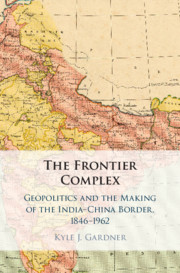Book contents
- The Frontier Complex
- The Frontier Complex
- Copyright page
- Dedication
- Contents
- Figures
- Maps
- Tables
- Additional material
- Preface
- Acknowledgments
- A Note on the Text
- Introduction
- 1 Territory before Borderlines
- 2 Surveys
- 3 Communication
- 4 Reading the Border
- 5 Trans-frontier Men
- 6 The Birth of Geopolitics
- 7 Lines of Control
- Epilogue
- Archives
- Bibliography
- Index
1 - Territory before Borderlines
Trade, Cosmology, and Modes of Seeing in Precolonial Ladakh
Published online by Cambridge University Press: 21 January 2021
- The Frontier Complex
- The Frontier Complex
- Copyright page
- Dedication
- Contents
- Figures
- Maps
- Tables
- Additional material
- Preface
- Acknowledgments
- A Note on the Text
- Introduction
- 1 Territory before Borderlines
- 2 Surveys
- 3 Communication
- 4 Reading the Border
- 5 Trans-frontier Men
- 6 The Birth of Geopolitics
- 7 Lines of Control
- Epilogue
- Archives
- Bibliography
- Index
Summary
The first chapter draws on Ladakhi and trans-Himalayan sources to examine precolonial understandings of space, boundaries, and frontiers in Ladakh and the broader northwestern Himalayan region. Sources surveyed range from the earliest available records of the tenth and eleventh centuries to the beginning of British rule in 1846. This chapter provides both a historical background to the region and an exploration of four major facets of indigenous Himalayan space: cosmology, politics, language, and matter. In illustrating multiple historical modes of seeing by indigenous historical actors, I suggest that the single, bounded entity called Ladakh was primarily a product of imperial possession in the nineteenth century. I am not arguing that there was not an earlier political entity known as Ladakh but rather that indigenous conceptions of its space were more pluralistic than the subsequent territory envisioned by its imperial rulers. The commingling of cosmological, political, linguistic, and material ways of seeing, I argue, produced identities that failed to map neatly. This chapter draws not only on the limited extant precolonial Ladakhi sources but also on an array of anthropological, linguistic, and archeological sources.
Information
- Type
- Chapter
- Information
- The Frontier ComplexGeopolitics and the Making of the India-China Border, 1846–1962, pp. 26 - 59Publisher: Cambridge University PressPrint publication year: 2021
